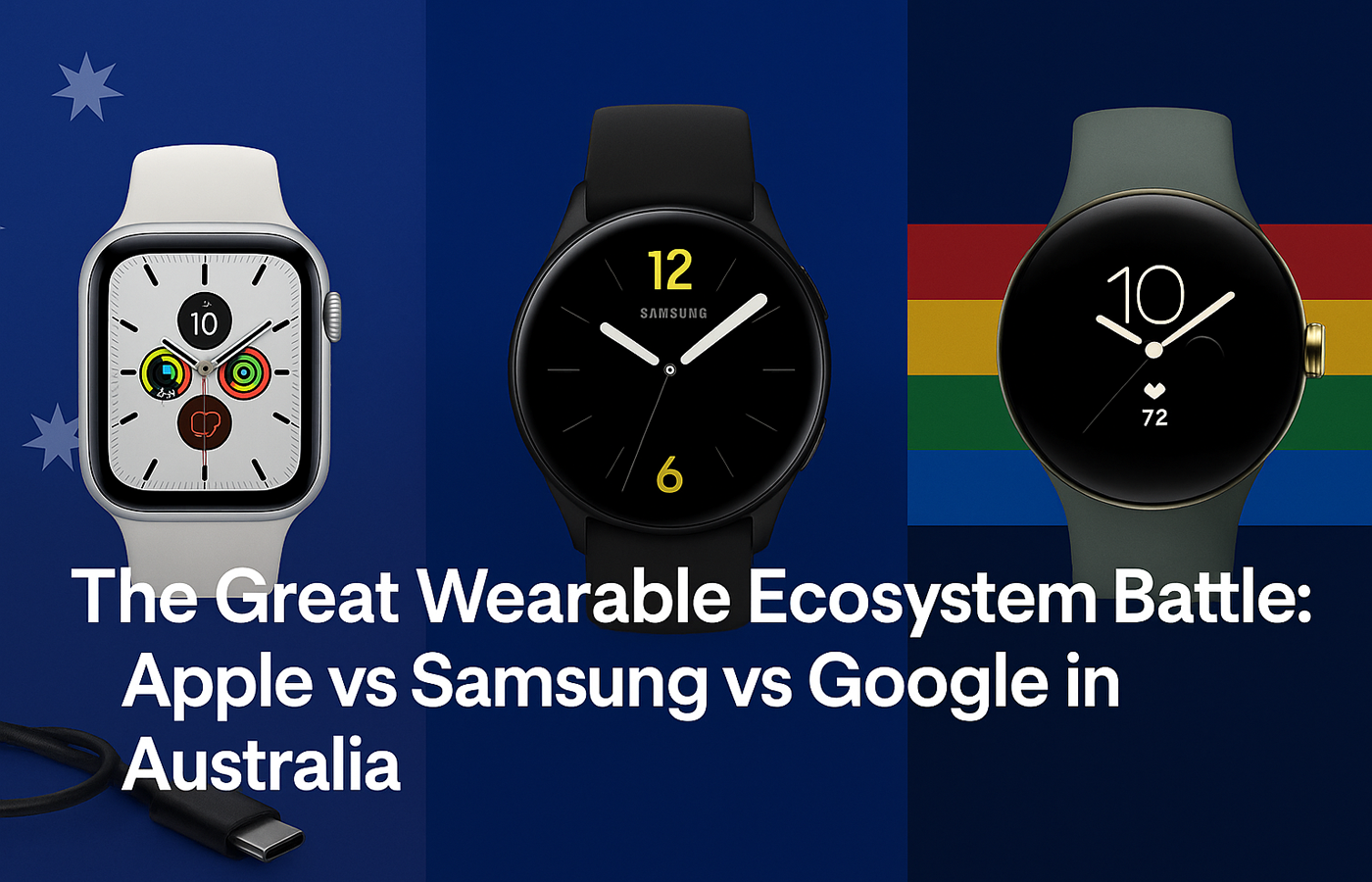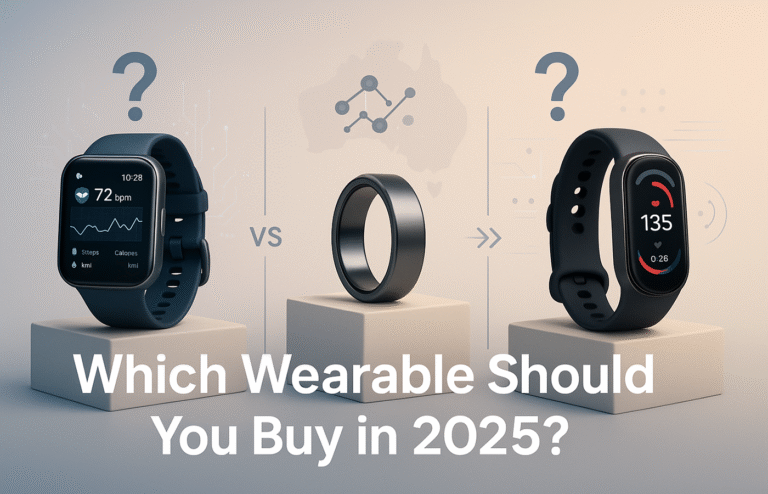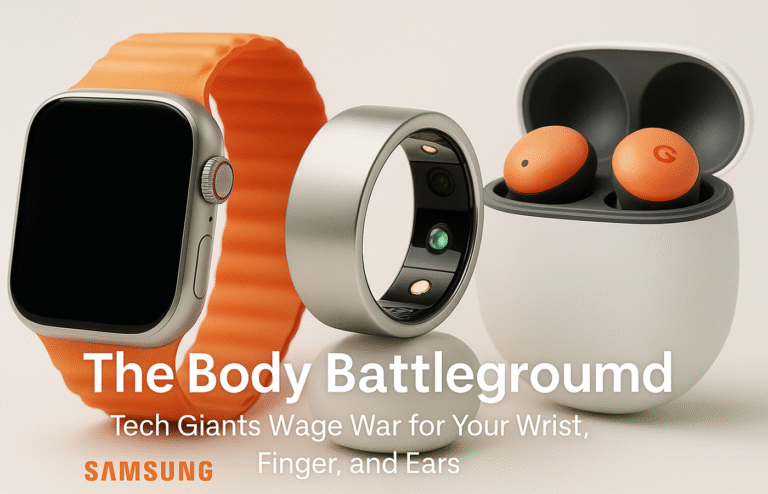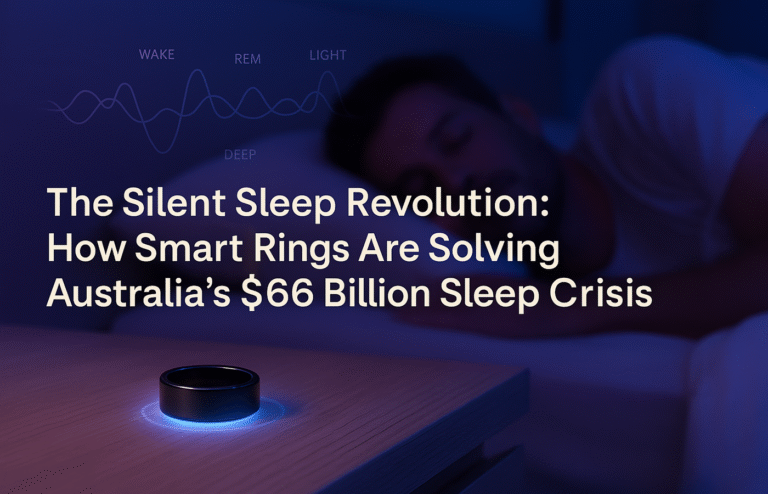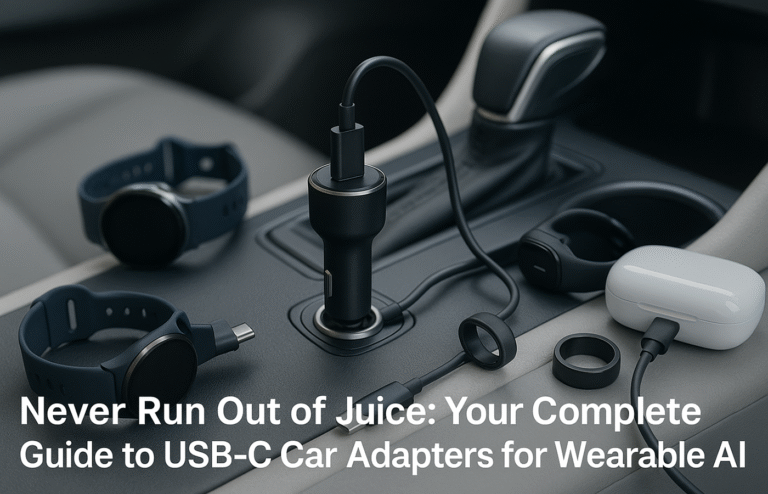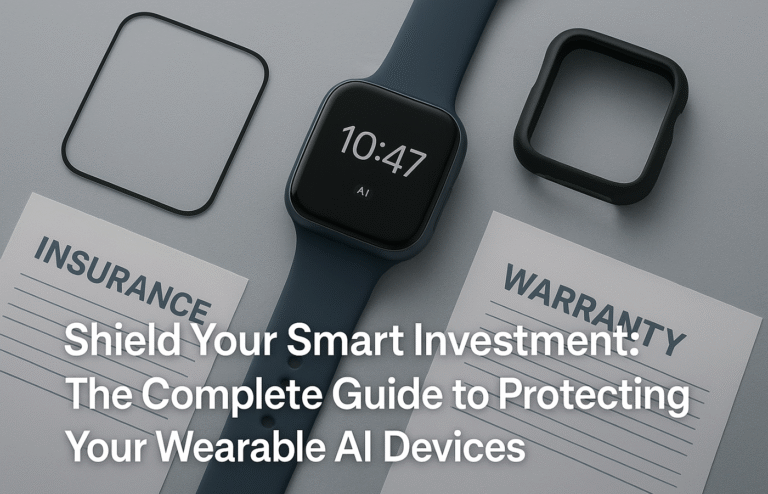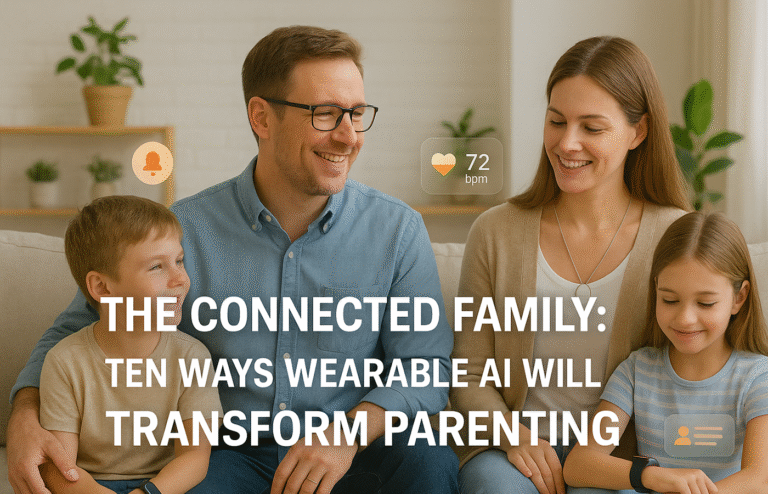Apple vs Samsung vs Google: Wearable Ecosystem Battle for Australian Consumers
Three tech giants compete for Australian wearable dominance, each offering distinct ecosystem advantages tailored to different user preferences and device compatibility needs.
Apple Ecosystem (Watch Series 10 from $629, SE from $399 AUD):
● Seamless integration across MacBook, iPhone, and iPad with superior health system compatibility
● Strongest carrier support from Telstra, Optus, and Vodafone with reliable eSIM provisioning
● Premium pricing justified by 4-5 years software updates and comprehensive local warranty support
Samsung Galaxy Watch Ecosystem:
● Broad Android compatibility with competitive trade-in programmes through major Australian retailers
● Advanced health monitoring including sleep tracking, stress analysis, and body composition features
● Improved 4-year software commitment matching Apple’s long-term support timeline
Google Pixel Watch ($449-549 AUD):
● AI-powered features through Google Assistant and Fitbit health expertise integration
● Superior natural language processing for hands-free use and Android Auto connectivity
The Great Wearable Ecosystem Battle: Apple vs Samsung vs Google in Australia
The wearable technology market has evolved into a three-horse race between tech giants Apple, Samsung, and Google. Yet for Australian consumers, the question isn’t simply which device offers the best features—it’s about which ecosystem delivers the most comprehensive experience down under. From carrier partnerships to health system integration, local app availability to long-term software support, each ecosystem presents distinct advantages and trade-offs for Aussie users.
Apple: The Premium Ecosystem Leader
Apple’s wearable ecosystem revolves around seamless integration with the broader Apple universe, and this integration delivers particularly strong value in the Australian market. The Apple Watch Series 10 (starting from an RRP of $629 AUD for GPS models) represents the pinnacle of this ecosystem approach, whilst the more affordable Apple Watch SE (RRP $399 AUD) provides essential features at a more accessible price point.
Ecosystem Integration Excellence
Apple’s greatest strength lies in how effortlessly its devices work together. Your Apple Watch unlocks your MacBook when you sit down, automatically syncs workout data to your iPhone’s Health app, and enables features like Handoff that let you start a task on one device and finish it on another. For Australian users who’ve invested in multiple Apple products, this interconnectedness creates genuine productivity benefits.
The health ecosystem particularly shines in Australia. Apple Health integrates with major Australian health apps like MyGov and various private health insurer platforms. Additionally, the ECG and blood oxygen monitoring features work seamlessly with Australian healthcare providers who accept consumer-generated health data.
Australian-Specific Advantages
Apple’s local presence in Australia translates to reliable warranty support through Apple Stores in major cities and authorised service providers nationwide. The company’s commitment to Australian Consumer Law compliance provides additional peace of mind for premium purchases. Moreover, Apple Pay enjoys widespread acceptance across Australian retailers, from major chains to local cafes using Square terminals.
Carrier integration represents another strong point. All major Australian carriers—Telstra, Optus, and Vodafone—support Apple Watch cellular connectivity with established eSIM provisioning. This ensures reliable service activation and ongoing support.
Limitations to Consider
Apple’s ecosystem demands complete buy-in. Android users need not apply, and even within the Apple ecosystem, older devices may lose compatibility over time. The premium pricing extends beyond the watch itself—genuine Apple accessories often cost significantly more than third-party alternatives, though quality and integration remain superior.
Samsung: The Android Alternative with Broad Appeal
Samsung’s Galaxy Watch ecosystem offers the most compelling alternative to Apple, particularly for Android users. The new Galaxy Watch8 (RRP varies by model and configuration) and Galaxy Watch Ultra (2025) provide feature-rich experiences that rival Apple’s offerings whilst maintaining broader device compatibility.
Versatile Ecosystem Integration
Unlike Apple’s walled garden approach, Samsung’s ecosystem demonstrates more flexibility. Whilst Galaxy Watches work best with Samsung smartphones, they remain functional with other Android devices. This openness extends to health data, where Samsung Health integrates with Google Fit, MyFitnessPal, and various Australian health platforms.
The One UI Watch interface provides a familiar experience for Samsung smartphone users, with shared design languages and feature sets. Bixby integration offers voice control capabilities, though its Australian English recognition still trails behind Google Assistant and Siri.
Australian Market Positioning
Samsung’s strong retail presence in Australia through partnerships with JB Hi-Fi, Harvey Norman, and other major retailers ensures widespread availability and competitive pricing. Trade-in programmes often provide better value than Apple’s offerings, particularly for older Samsung devices.
The company’s health ecosystem shows particular promise in Australia. Samsung Health’s integration with Australian fitness chains and its partnership with local health researchers for sleep and stress studies demonstrates genuine commitment to the local market.
Health and Fitness Focus
Samsung’s recent focus on advanced health monitoring sets it apart. The Galaxy Watch Ultra features comprehensive sleep tracking, stress monitoring, and body composition analysis. These features integrate well with Australia’s growing corporate wellness sector, where employers increasingly adopt wearable technology for staff health programmes.
Ecosystem Challenges
Samsung’s ecosystem lacks the depth of Apple’s integration. Whilst Galaxy Watches work with Windows PCs and Android tablets, the experience feels less cohesive than Apple’s approach. Additionally, Samsung’s software update commitment, whilst improving, doesn’t match Apple’s long-term support timeline.
Google: The AI-Powered Newcomer
Google’s Pixel Watch ecosystem represents the newest approach, leveraging artificial intelligence and deep Android integration. The Pixel Watch 3 (RRP from $449 AUD for 41mm, $549 AUD for 45mm) brings Google’s expertise in AI and services to the wearable space.
AI-First Approach
Google’s core strength lies in intelligent features powered by machine learning. Google Assistant on Pixel Watch provides superior natural language processing compared to competitors, particularly valuable for hands-free use during workouts or while driving. The integration with Google’s broader AI ecosystem means features like real-time translation, smart replies, and predictive fitness coaching continue improving over time.
The Fitbit integration brings established health tracking expertise to Google’s ecosystem. Sleep tracking, heart rate monitoring, and activity recognition leverage years of Fitbit’s data science expertise, providing insights that often surpass hardware-focused competitors.
Australian Integration Benefits
Google’s services enjoy deep integration with Australian digital infrastructure. Google Pay adoption rates in Australia remain high, Maps provides superior local navigation data, and Google Calendar integration with Australian business systems offers practical advantages.
The Pixel Watch’s integration with Android Auto makes it particularly valuable for Australian commuters. Voice control for navigation, messaging, and music playback works seamlessly across supported vehicles, increasingly important given Australia’s car-dependent lifestyle in many regions.
Ecosystem Limitations
Google’s wearable ecosystem remains the most limited of the three. Pixel Watch requires Android 8.0 or newer, excluding iPhone users entirely. Moreover, the Google ecosystem lacks the hardware diversity found in Apple or Samsung offerings—no tablets specifically designed for ecosystem integration, limited laptop options, and fewer accessory choices.
Battery life represents another concern. Whilst sufficient for daily use, Pixel Watch doesn’t match the multi-day performance of Samsung’s larger models or the Apple Watch Ultra’s extended battery options.
Carrier Partnerships and Connectivity
Australian carrier support varies significantly across ecosystems. Apple maintains the strongest partnerships, with all major carriers offering Apple Watch cellular plans and streamlined activation processes. Samsung follows closely, though some smaller carriers may have limited Galaxy Watch support.
Google’s Pixel Watch cellular support remains more limited, with Telstra and Optus providing primary support whilst Vodafone’s offerings vary by plan. This disparity affects users who rely on standalone watch connectivity for fitness activities or emergency situations.
Health System Integration
Australia’s digital health ecosystem shows varying compatibility across wearable platforms. Apple Health integrates most seamlessly with MyHealth Record and major private health insurers’ apps. Samsung Health provides good compatibility but requires more manual data sharing. Google’s Fitbit platform offers extensive third-party integrations but less direct healthcare system connectivity.
The practical impact affects users who want wearable data included in health assessments or insurance premium calculations. Apple’s approach typically requires fewer intermediary apps or manual data exports.
Long-Term Software Support
Software longevity represents a crucial factor often overlooked in initial purchase decisions. Apple typically provides 4-5 years of major watchOS updates, ensuring feature parity and security updates throughout the device’s practical lifespan.
Samsung’s commitment has improved significantly, now offering 4 years of software updates for Galaxy Watch models. This brings parity with Apple’s approach whilst providing confidence in long-term device viability.
Google’s Pixel Watch commitment remains shorter at 3 years of major updates, though this may extend as the platform matures. The integration with Wear OS development cycles may provide additional feature updates beyond Google’s specific commitment timeline.
The Australian Verdict
For Australian consumers, ecosystem choice depends largely on existing device preferences and lifestyle requirements. Apple delivers the most cohesive experience for users already invested in the ecosystem, with superior integration, local support, and health system compatibility justifying premium pricing.
Samsung provides the best balance of features, compatibility, and value. Galaxy Watch models offer advanced health tracking with broader device compatibility, making them ideal for Android users who want flagship features without ecosystem lock-in.
Google’s Pixel Watch appeals to users prioritising AI features and deep Android integration. Despite ecosystem limitations, the combination of Google services, Fitbit health expertise, and competitive pricing creates compelling value for Android-first users.
Rather than declaring a single winner, the Australian market benefits from genuine competition. Each ecosystem delivers distinct advantages, encouraging innovation whilst providing consumers with choices that match their technological preferences and budgets. The key lies in understanding which ecosystem aligns with your existing devices, preferred services, and long-term technology plans.
The future of wearable ecosystems in Australia looks increasingly bright, with each major player demonstrating genuine commitment to local market needs through carrier partnerships, health system integration, and ongoing software development. Whether you choose Apple’s premium integration, Samsung’s versatile approach, or Google’s AI-powered innovation, Australian consumers have access to world-class wearable technology designed to enhance daily life.

